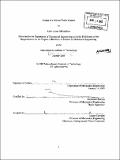| dc.contributor.advisor | Alexander Slocum. | en_US |
| dc.contributor.author | Mukaddam, Kabir James, 1983- | en_US |
| dc.contributor.other | Massachusetts Institute of Technology. Dept. of Mechanical Engineering. | en_US |
| dc.date.accessioned | 2006-05-15T20:33:24Z | |
| dc.date.available | 2006-05-15T20:33:24Z | |
| dc.date.copyright | 2005 | en_US |
| dc.date.issued | 2005 | en_US |
| dc.identifier.uri | http://hdl.handle.net/1721.1/32833 | |
| dc.description | Thesis (S.B.)--Massachusetts Institute of Technology, Dept. of Mechanical Engineering, 2005. | en_US |
| dc.description | Includes bibliographical references (leaf 46). | en_US |
| dc.description.abstract | Usually multiple MEMS or IC devices are fabricated on a single silicon wafer. Manually separating the components from each other involves scribing and fracturing the silicon. This thesis presents a design for a tool to aid in controlling the fracturing process. An earlier prototype of this tool was examined and new functional requirements were described. One of the functional requirements is that the tool cannot touch the top of the wafer because the top might have delicate components. The wafer breaker was designed to hold the wafer on two plates, where one of them is hinged. The wafer is scribed above the hinge line, and the hinged plate is pushed down to fracture the wafer. Several methods of holding the wafer down with vacuum were investigated. Bench level prototypes were constructed to test the feasibility of the methods. The prototype with a grid of pockets and flow restrictors performed the best. Even when the wafer only partially covered the grid, the covered pockets maintained a high vacuum. A clamped flexure was used as the hinge for the tool. The instant center of the hinge was calculated for small deflections, and was aligned with a scribe guide. This forces the scribed notch to be directly above the hinge line. A prototype wafer breaker was constructed and tested. The prototype worked, but in many cases where the (111) silicon plane was not parallel or orthogonal to the scribe line, the crack line would leave the scribe line and follow the crystal plane. This problem would also be encountered by those manually breaking wafers. | en_US |
| dc.description.statementofresponsibility | by Kabir James Mukaddam. | en_US |
| dc.format.extent | 46 leaves | en_US |
| dc.format.extent | 2812699 bytes | |
| dc.format.extent | 2812982 bytes | |
| dc.format.mimetype | application/pdf | |
| dc.format.mimetype | application/pdf | |
| dc.language.iso | eng | en_US |
| dc.publisher | Massachusetts Institute of Technology | en_US |
| dc.rights | M.I.T. theses are protected by copyright. They may be viewed from this source for any purpose, but reproduction or distribution in any format is prohibited without written permission. See provided URL for inquiries about permission. | en_US |
| dc.rights.uri | http://dspace.mit.edu/handle/1721.1/7582 | |
| dc.subject | Mechanical Engineering. | en_US |
| dc.title | Design of a silicon waver breaker | en_US |
| dc.type | Thesis | en_US |
| dc.description.degree | S.B. | en_US |
| dc.contributor.department | Massachusetts Institute of Technology. Department of Mechanical Engineering | |
| dc.identifier.oclc | 60689124 | en_US |
